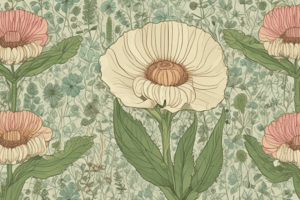Podcast
Questions and Answers
What distinguishes angiosperms from other plant groups?
What distinguishes angiosperms from other plant groups?
Which of the following terms is associated with the lifecycle of an angiosperm?
Which of the following terms is associated with the lifecycle of an angiosperm?
Which class under the Division Anthophyta includes dicotyledons?
Which class under the Division Anthophyta includes dicotyledons?
Which of the following structures is NOT found in a perfect flower?
Which of the following structures is NOT found in a perfect flower?
Signup and view all the answers
In the plant kingdom, which group is characterized by a life cycle that includes a prominent sporophyte stage?
In the plant kingdom, which group is characterized by a life cycle that includes a prominent sporophyte stage?
Signup and view all the answers
Which plant characteristic is common to all vascular plants?
Which plant characteristic is common to all vascular plants?
Signup and view all the answers
What characteristic is NOT true about the Kingdom Plantae?
What characteristic is NOT true about the Kingdom Plantae?
Signup and view all the answers
In the life cycle of a moss, which stage is dominant?
In the life cycle of a moss, which stage is dominant?
Signup and view all the answers
What is the primary feature that allows ephedra viridis, commonly known as Mormon tea, to survive in its environment?
What is the primary feature that allows ephedra viridis, commonly known as Mormon tea, to survive in its environment?
Signup and view all the answers
Which of the following features is NOT associated with pterophytes?
Which of the following features is NOT associated with pterophytes?
Signup and view all the answers
Which of the following statements is true regarding the classification of angiosperms?
Which of the following statements is true regarding the classification of angiosperms?
Signup and view all the answers
Which component is critical for the structure of plant cell walls in the Kingdom Plantae?
Which component is critical for the structure of plant cell walls in the Kingdom Plantae?
Signup and view all the answers
What is the process termed when there is a shift between gametophyte and sporophyte generations in plants?
What is the process termed when there is a shift between gametophyte and sporophyte generations in plants?
Signup and view all the answers
Which of the following statements about mosses is TRUE?
Which of the following statements about mosses is TRUE?
Signup and view all the answers
Which compound is produced by plants that aids in providing structural support and resistance to decay?
Which compound is produced by plants that aids in providing structural support and resistance to decay?
Signup and view all the answers
In mosses, which organ is primarily involved in the production of spores?
In mosses, which organ is primarily involved in the production of spores?
Signup and view all the answers
What stage of the fern life cycle is dominant?
What stage of the fern life cycle is dominant?
Signup and view all the answers
Which of the following characteristics is NOT found in vascular plants?
Which of the following characteristics is NOT found in vascular plants?
Signup and view all the answers
What are sporangia in ferns typically covered by?
What are sporangia in ferns typically covered by?
Signup and view all the answers
Which of the following structures is associated with the apical meristem of plants?
Which of the following structures is associated with the apical meristem of plants?
Signup and view all the answers
In the Pterophyta group, which characteristic is common among horsetails?
In the Pterophyta group, which characteristic is common among horsetails?
Signup and view all the answers
What is contained in seeds produced by seed plants?
What is contained in seeds produced by seed plants?
Signup and view all the answers
Which type of plant is most commonly represented in the tropics?
Which type of plant is most commonly represented in the tropics?
Signup and view all the answers
How do gametophytes in seed plants exist?
How do gametophytes in seed plants exist?
Signup and view all the answers
Study Notes
BIOL 105 - Chapter 14: Introduction to Biology
- Plants are crucial in human societies, playing an integral role in many aspects of human life.
- Plants' role is exemplified by various examples: palm trees, wheat crops, cotton plants, and opium poppies.
- Plants have various roles and influence, from providing food to serving as a medicinal and agricultural resource.
- Different plants exhibit specific adaptations contributing to their survival and propagation.
- The alternation of generations in the life cycle of a moss is characterized by a dominant gametophyte stage and the presence of mosses to show the phenomenon.
- Plants exhibit a wide range of diversity and adaptations, which are presented in various diagrams throughout the notes.
- Certain plant species, such as ferns, are prevalent in tropical regions, demonstrating significant biological diversity.
- In particular, the life cycle of certain plants, such as ferns, showcases alternation of generations with a dominant sporophyte stage.
- Horsetails, a type of fern, are characterized by their ribbed stems, silica content, and reduced leaves arranged in whorls.
- Horsetails are prevalent in moist environments and are well represented in the fossil record.
- Seed plants possess a unique characteristic: their gametophytes are never free-living.
- A seed contains an embryo derived from a female gametophyte and plays a crucial role in plant dispersal.
- Additional examples include various fruit structures and types.
- Different plant groups, such as gymnosperms and angiosperms, display unique adaptations and reproductive strategies.
- Angiosperms exhibit significant diversity and are incredibly widespread across various geographic regions, showcasing their evolutionary success.
- Angiosperms are characterized by two major classes: Monocots and Dicots.
- Angiosperms display a remarkable diversity of flowers and fruits, supporting many different animal species and playing vital roles in the food chain.
Defining Kingdom Plantae
- Plants are multicellular and photosynthetic autotrophs.
- Plant cell walls are composed of cellulose, and starch is used for storage.
- Plants obtain nutrients from the soil and oxygen and carbon dioxide from the air through stomata.
- Internal fertilization (embryophytes) is a key characteristic of plants.
- Plants exhibit alternation of generations in their life cycle. They produce lignin and sporopollenin.
Alternation of Generations
- The life cycle involves a multicellular diploid generation (sporophyte) and a multicellular haploid generation (gametophyte).
- Gametes (haploid) combine through fertilization to form a diploid zygote.
- Mitosis leads to the development of sporophytes and gametophytes.
- Meiosis occurs to produce haploid spores.
Evolutionary Relationships of Plants
- Plants evolved from a common ancestor (Ancestral Algae).
- The evolutionary history of plants can be visualized through various taxonomic classifications and diagrams.
- This illustrates the evolutionary relationship and transitions throughout different groups.
- Origins of land plants are marked by specific events and times in the evolutionary history, indicating major evolutionary changes.
Bryophyta - Mosses
- Mosses form dense mats of tightly packed plants.
- They lack true stems, leaves, and roots.
- Both the gametophyte and sporophyte are large in mosses.
- Sphagnum moss holds significant ecological importance.
Sphagnum Bog
- This is an environment inhabited by Sphagnum moss.
The Vascular Plants - Tracheophytes
- Vascular plants possess true roots, stems, and leaves.
- They contain vascular tissue (xylem and phloem).
- Lignification is essential in supporting the growth of trees and other larger vascular plants.
Apical Meristems
- These are responsible for the growth of plant roots and shoots.
Pterophyta - Ferns
- Ferns are well-represented in tropical regions, exhibiting significant diversity.
- Their large leaves, divided into fronds, are a distinct feature.
- Sporangia are on the underside of the fronds, often clustered in structures called sori.
Pterophyta - Horsetails
- Horsetails are abundant in the fossil record, with some species reaching heights of up to 15 meters.
- They exhibit ribbed stems, and small leaves that emerge in whorls at each joint, providing specific characteristics.
- A single extant genus, Equisetum, remains present today, illustrating the persistence of this plant lineage.
The Uniqueness of Seeds
- Seeds contain the embryo and support dispersal.
- Pollen contains the male gametophyte.
- Gametophytes are never free-living in seed plants.
Flower/Pollinator Adaptations
- Generalist pollinators (e.g., honeybees) and specialized ones (e.g., hummingbirds and beetles) interact with plants displaying different adaptations.
Seed Dispersal Adaptations
- Seeds are dispersed with specific adaptations: including winged seeds, edible parts, hooks, and bristles.
The Value of Angiosperms
- Angiosperms serve as food sources for people and animals, with notable examples like rice and maize.
- They also provide sources for medicines and other valuable substances.
- Essential in the overall ecosystem (e.g., absorbing carbon dioxide and releasing oxygen).
Most Important Staple Foods in the World
- The major staples commonly consumed globally are listed.
Fruits
- Various types of dry and fleshy fruits exist.
Division Anthophyta
- Angiosperms represent the most diverse and widespread plant division.
- Two major classes exist within the Angiosperms: Monocots and Dicots.
Flower Anatomy
- Flowers have distinct components like petals, sepals, stamens, and carpels.
Angiosperm Life Cycle
- Angiosperms exhibit a life cycle including processes like pollination, double fertilization, and seed development.
Monoecious and Dioecious Plants
- Plants may exhibit monoecious or dioecious characteristics.
- Monoecious species have both male and female sexual organs in a single plant.
- Dioecious species have separate male and female plants.
Studying That Suits You
Use AI to generate personalized quizzes and flashcards to suit your learning preferences.
Related Documents
Description
Explore the critical role of plants in human life through this quiz based on Chapter 14 of BIOL 105. Learn about their various adaptations, life cycles, and contributions to food and medicine. Enhance your understanding of plant diversity and the alternation of generations in different species.




